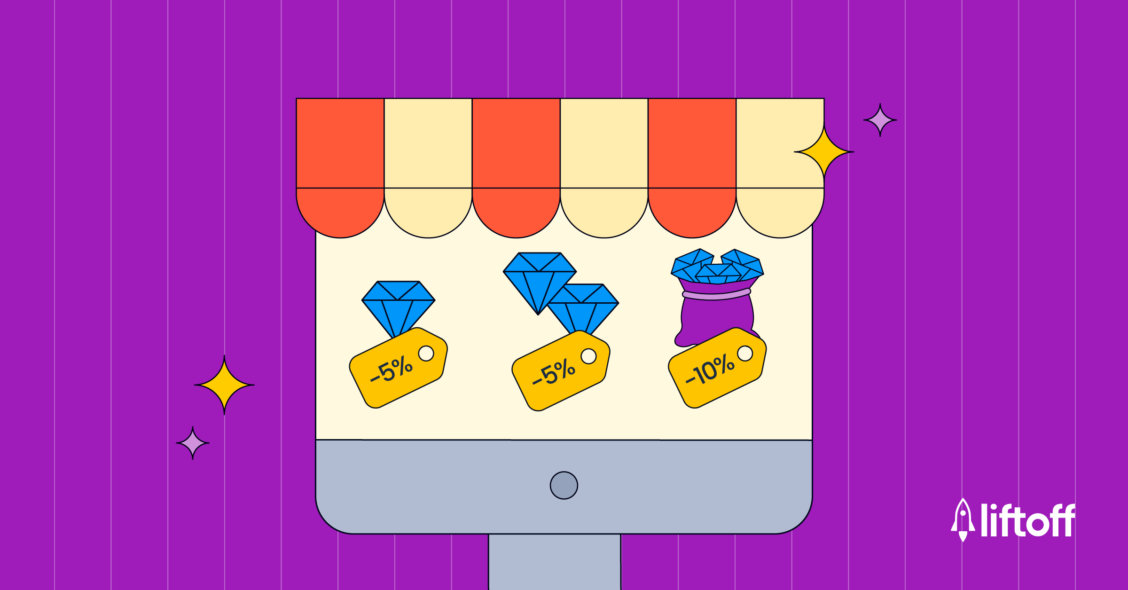
Can You Unlock More and Spend Less by Going Around the App Stores?
One of the newest and most unusual trends you may have spotted on mobile apps is the rise of external web stores. App publishers—especially those focused on mobile games—are increasingly pushing users to make in-app purchases at publishers’ websites to circumvent the Google Play and App Store’s 30% app transaction fees.
The origins of this trend can be traced back to 2020, when Epic Games gave Fortnite players on iOS and Android the ability to buy a premium in-game currency, V-Bucks, directly from their website for a 20% discount. As a result, Apple and Google removed Fortnite from their storefronts, stating that bypassing their payment systems violated their terms of service.
The removal from the app stores prompted Epic to file a lawsuit against the two mobile platform holders, stating they have an unlawful oligopoly on mobile app transactions. Since then, the standoff between Apple and Epic has mostly come to a close, with the courts ruling in Apple’s favor in almost all cases except for one. Apple must no longer intervene if an app provides links, buttons, or other calls to action to external stores or alternative purchasing mechanisms.
According to GameRefinery, this has led to a notable number of mobile games jumping on the trend, including Game of Thrones: Conquest, Clash of Clans, and Star Wars: Galaxy of Heroes. So if you’re considering getting involved and experimenting with your external web stores, here are some key things you should keep in mind.
External web stores must provide worthy deals to entice users
One of the biggest challenges with external web stores is how difficult it is to get people to use them. Buying a product directly through the app stores is secure and convenient for users, whereas going through an external store involves added friction layers, such as creating an additional account and re-entering payment details.
Users are unlikely to go to the extra effort if it won’t be worth their while, which is why most current apps utilizing external web stores offer exclusive offers. For example, Game of Thrones: Conquest provides a package of 10,000 jewels, a form of in-game currency, for 10% less on its website than if they were purchased directly through the app stores.
Do you have somewhere to host an external web store?
The most obvious and important thing to consider when it comes to external web stores is having the facilities to host one.
The apps currently running their web stores successfully were already performing well. They had the backing of a large publisher, meaning it wasn’t an enormous undertaking to put everything into place. Managing web stores may be a significant entry barrier for smaller apps and publishers with fewer resources.
Visibility and accessibility of external web stores is an issue
While the Apple v. Epic ruling may mean developers and publishers are free to include shortcuts to external web stores within their apps, some restrictions remain. Primarily, it’s still very much prohibited to advertise the existence of external stores beyond the shortcut itself, making it very difficult to encourage people to use it.
However, no rules prevent mobile marketers from advertising their external deals elsewhere, such as through social media channels or traditional online ads.
Subscriptions and external stores would be a powerful combo
Another trend that has appeared in the mobile market in recent years is the rise of subscription-based apps. According to our recent report, there was a 35% rise in total consumer spend on subscription-based iOS apps in the first four months of 2023 and an increase of 24% on Android. Install-to-subscription conversion rates have also surged, rising 20% YoY on Android and 15% on iOS.
These subscription models are offered directly through Google Play and the App Store, meaning publishers lose 30% of their subscription-based revenue to store transaction fees.
Unfortunately, at the time of writing, it’s not currently possible for subscription services to circumvent these fees through an external web store.
However, there is one exception to the rule: reader apps. Following an investigation by the Japan Fair Trade Commission, these apps have had the freedom to allow users to set up and manage accounts on external websites around the world since early 2022. Hopefully, other subscription apps will be given similar leeway in the near future.
The rise of external web stores might be shortlived
External web stores might be going strong, but Apple is determined to get the ruling overturned and is in the process of appeal to the U.S.> Supreme Court. The technology giant was recently granted a 90-day reprieve from the earlier ruling to give it time to file the necessary paperwork. However, it’s yet to bring down the hammer on those who have already got on the bandwagon—likely as the court may deny even to hear the appeal.
Suppose Apple does manage to overturn the ruling. That likely won’t mean the complete end of external web stores, especially given the EU’s new digital market laws, forcing Apple to allow third-party app stores on its various platforms from 2024. However, they may become a far less profitable prospect.
A long-running dispute between Apple and the Netherlands Authority for Consumers and Markets (ACM) might provide insight into what we could expect. Apple was mandated to allow local dating apps to take payments through third-party processors, which it has since put into place with the caveat of a 27% commission fee.
If the same happens to external web stores, many publishers will likely feel they’re no longer worth pursuing. For now, all developers and publishers can do is proceed carefully, knowing there is probably more to change before app marketers have clarity and can build external web stores into their monetization strategies.

If you enjoyed this post and want to learn more about external web stores, grab our 2023 Midcore Gaming Apps Report →
